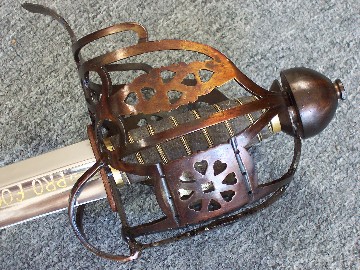Posts: 264 Location: Janesville, WI
Mon 20 Nov, 2006 9:28 am
I've been horribly remiss in posting my attempts at linseed blackening, so finally here are some pictures of my attempts.
[ Linked Image ]
Buckler with 3 years of light use. The method used for this one was to paint on some boiled linseed oil with a cloth so there was a thin layer all over the surface. I then put the buckler on a grate over a charcoal fire and heated it until the color was one I liked.
[ Linked Image ]
[ Linked Image ]
[ Linked Image ]
[ Linked Image ]
[ Linked Image ]
Burgonet that has a devotion to St. Michael scratched into the blackening. This one I did the same light coat of boiled linseed oil on but hung the helmet from a camp tripod over a charcoal fire and filled the skull of the helmet with burning coals. The effect was good, but the comb and part of the brim didn't get fully black. Instead they remained a dark brown. You can sort of see the scratched in devotion to St. Michael in the last picture.
[ Linked Image ]
[ Linked Image ]
The last is an old starfire dagger that I had lying around. I stripped it of its wrap and threw the hole thing in an oak and charcoal fire. Once it was "good 'n' hot", I took it out with some tongs and dipped it in a bucket of linseed oil. You can see some bubbles and debris that was stuck to the blade when it was dipped in the oil. In hind sight I'm probably very luck the whole bucket didn't catch on fire.
I hope that helps visualize what I was describing.
